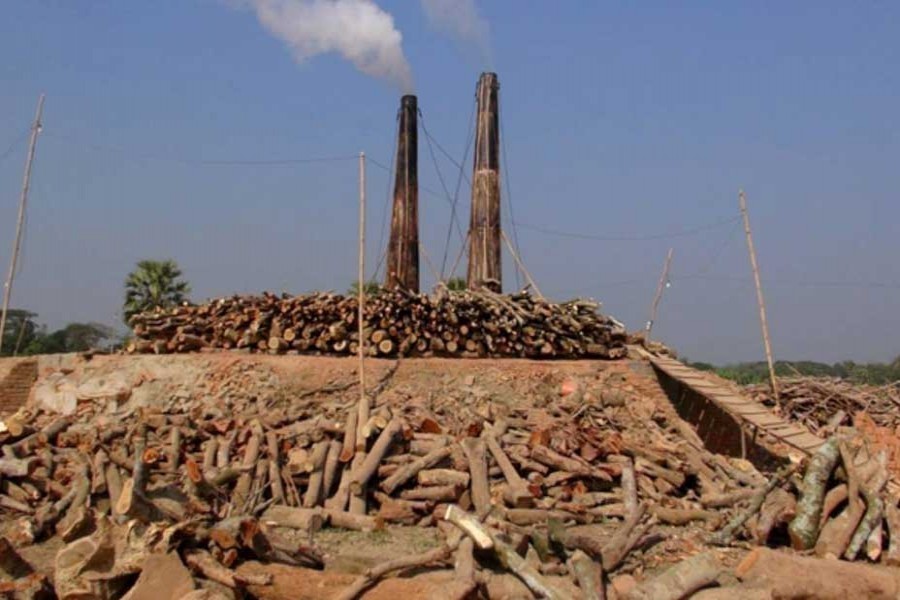Strange it indeed is that the High Court's (HC) repeated rulings prohibiting brick making by illegal brick kilns in the country are not being heeded to by none other than the government agencies. The last in the series of such rulings from the highest court came weeks ago. This time the HC asked the Deputy Commissioners of all districts to issue notifications within seven days banning the operation of all illegal brick kilns. The court also asked the government to explain within four weeks why its failure to stop the operation of illegal brick kilns and use of fuel woods in brick kilns should not be declared illegal.
There were several such directives in the past. Months back, on March 1, 2022, the High Court directed the Director General of the Department of Environment (DoE) and the DCs of Dhaka, Munshiganj, Narayanganj, Gazipur and Manikganj districts to demolish 319 illegal brickfields within 15 days. Some actions were reportedly taken, but only partly -- as though as a face saving measure.
The narrative of defiance is long, going back years, and hence there are reasons to worry whether reining in the operation of the hazardous brick kilns is really is possible. It is not just the media reports or the environmentalists' concern about the ruinous effects of these illegal structures that have failed to prevent the unabated misdeed but flouting of law stipulating the dos and don'ts in this regard is worrying enough to make one lose hope.
There is hardly any argument that among the many hazards affecting the environment, brick making is one that not only adversely affects the ecosystem but also leaves a disastrous impact on a host of livelihood means of the masses, notably among others, cultivation. This is particularly so when it comes to conventional brick making practices in the country for ages.
Emergence of brick kilns irrespective of locations has been on the rise for decades, facilitated largely by the absence of any enforceable rules. This is not to say there was no law governing brick making. The Brick Burning (control) Act 1989 had its inadequacies to dictate terms in the first place, and besides, the lacuna in the enforcement of some of the compliance issues made things worse. Consequently, the practice of setting up brick plants at any location of choice went unopposed.
The law currently in force apparently addresses the core issues associated with brickmaking -- meant chiefly to check widespread environment pollution as well as save arable land and forest. The law 'Brick Making and Brickfield Establishment (Control) Act 2013' has brought tough regulations for brick production that among others provides for trial of offences under the penal code. The stipulations envisaged in the law apply to all brick kilns in the country. The law prohibits establishment of brick kilns in residential, protected, commercial and agricultural locations, and also in forests, sanctuaries, wetlands and ecologically critical areas.
According to the Department of Environment (DoE), there are well over 6,000 brickfields in the country, of which around 3,000 are located in and around Dhaka. However, environmentalists claim the number is far higher. According to a UNDP estimate, Bangladesh produces some 8.66 billion bricks a year valued at $450 million -- almost 1.0 per cent of the country's GDP. Despite the sizeable contribution of brickmaking to the economy, one of the grim realities is that brick fields all over the country are getting increasingly invasive in grabbing the country's less than sufficient arable lands. More dangerous is the threat that comes in terms of affecting neighbourhood lands under cultivation because of the heat, caustic smoke and dust generated by the brickmaking plants. A local daily reports that over 6.4 million tonnes of carbon emissions are caused by the brick kilns annually.
As things are going unabated despite the law in force, it is clear that mere formulation of the law didn't help -- although the law was a foremost necessity and it did take a lot of things to work on. If not enforced in the right spirit, a law is no more than expression of intent. The job, no doubt, is challenging given the vast swathes of land, mostly agricultural, occupied by brickmaking plants. Disciplining these in line with the law is one thing, and setting up new plants is another. The law does not categorically mention relocation or phasing out of the outmoded plants from the prohibited areas. Experts feel there should have been clear guidelines in the law for setting up of new plants adopting green technology.
Concerned quarters emphasise the need for introducing modern green technology capable of taking care of the pollution aspect to a great extent. Some brickmaking plants in the country have moved in that direction, and in view of the wide acceptance of the technology in many countries chiefly because of its emission-preventing device, Bangladesh should move in a concerted way to facilitate wide acceptance of the technology. It is highly imperative that the government gradually phased out the traditional kilns, and provided necessary support by way of soft-term financing to encourage the green technology.


